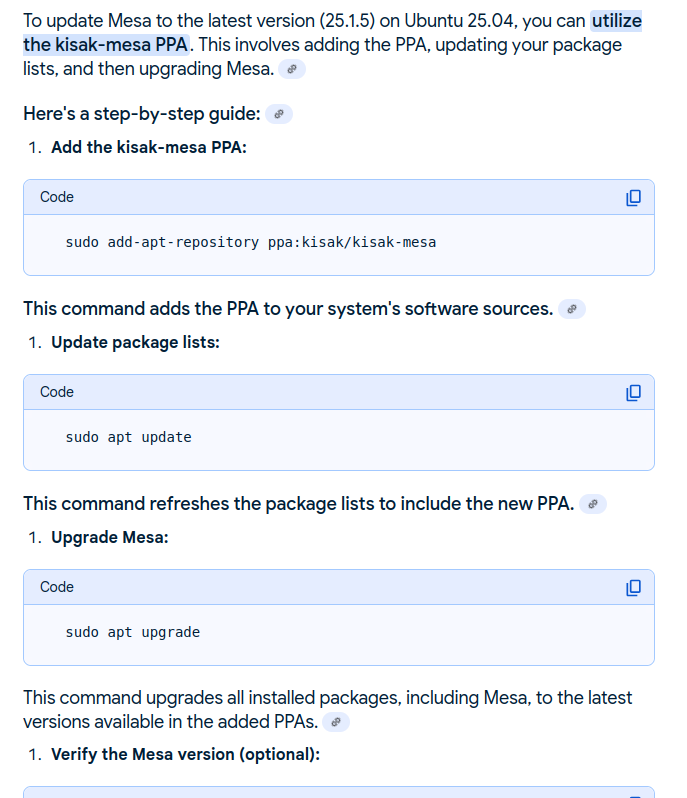Ubuntu Version:
25.04
Desktop Environment (if applicable):
All or some of the above.
Problem Description:
Was considering “Mesa”. Saw the website, and noticed there are many updates. Looked up how to update, got this:

…
…
…
Ubuntu Version:
25.04
Desktop Environment (if applicable):
All or some of the above.
Problem Description:
Was considering “Mesa”. Saw the website, and noticed there are many updates. Looked up how to update, got this:

…
So, that is it for today. So nice outside. I’ll leave this tidbit:
https://www.gamingonlinux.com/2025/07/its-now-easier-to-get-mesa-25-1-on-the-latest-ubuntu-25-04/
Something about removing “PPA’s” before updating Ubuntu Linux. I would most likely forget this. Will it mess things up? Should I not even bother?
Thanks.
I would only recommend using the PPA for mesa if your graphics hardware is too new to be supported by the included version of mesa.
Using the PPA can cause issues with upgrades, though Canonical tries to workaround potential issues. If I remember correctly, they disable third party PPAs during the upgrade process.
Exactly. Why can’t they coordinate these things better?
And what is a “PPA”, anyhow?
A PPA is a personal package archive usually created and maintained by a user or group. An official PPA can be created by a known software provider.
Some time ago there was attempt to use 3rd party drivers like nvidia proprietary in allowing non-free, multiverse or universe drivers, also in Debian there is dedicated sections for that, but also Debian Blends or specialized categoriez like is in WordPress world common practices.
In snaps there is gpu stack which could be used, but if there is(or was) nvidia drivers, it could mean futher nvidiaverse world and now also intel world(which currently means a lot), but futher approaches are also common in science world, and stacks… like Microsoft repos for a huge list of sw including db…s
if desired because some packages should be visible only to those who are in such obligation to know that. And thats problem currently with a huge list of packages, like is problem with Google Play with chinese packages with their landing page in chinese and not regional settings applied. Including choosing the way the Distro make it to deliver, and laws to apply
I also see there are new versions of “Gnome” and “Wayland”.
Do I need to or should I want to install these on my Ubuntu Linux 25.04 system? I see all this stuff come in various newsletters and websites, and it is pretty overwhelming. I want to make sure I keep up to date on things.
Thank you.
For the most stable experience, just apply updates/security fixes normally (ie. standard sources & apt update to update what your machine sees as being available, and apt upgrade [or apt full-upgrade when required; which is extremely rare!] to apply those upgraded packages to your system.
Fixes are back-ported to existing packages mostly on a ‘stable release’ system like Ubuntu, but some [minor] updates will occur; but the major updates will occur when you release-upgrade from 25.04 you’re now using to 25.10 late October (or in the 3 months after that when you decide you’ll upgrade) etc.
If you start adding third party sources to get the updated packages now; you do risk making the release-upgrade process more difficult come October+ (unless whomever packages them has been very careful and considerate of the future).
Maybe useful - Upgrade Ubuntu desktop | Ubuntu
So, just let it ride then? Pay no attention to all the “bug fixes” and “performance improvements” for now?
The only thing I have updated beyond what came with the computer was Wine, because it looked like it was pretty straightforward, and had some decent new things and likely would not need anything beyond that for quite some time.
So, all this Wayland/Gnome/Mesa/kernel/whatever stuff should just be left alone until it is time to upgrade the Ubuntu Linux 25.04 itself, and then let THAT pull in the latest at that time?
Why don’t the Ubuntu people, and the people who are doing these other updates coordinate better, so this would not be a problem?
Ubuntu has its releases in April and October, which is on purpose, as it aligns best with the release dates of upstream GNOME project, with the added time required to package, test etc. after release by upstream (ie. Ubuntu has its own freeze dates to ensure stability).
Of course Ubuntu being a GNU/Linux system, includes code/software from more than just the GNOME project , but date April & October release dates are heavily influenced on when the GNOME project releases.
Good point. Thank you.